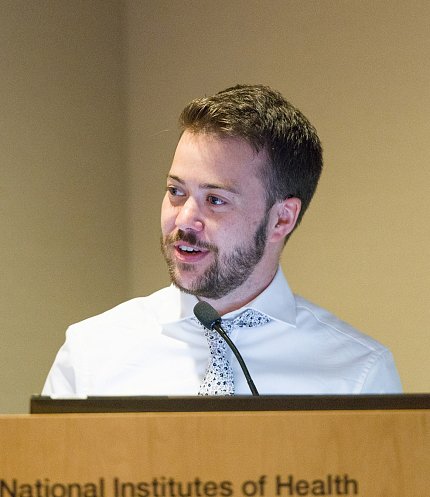LGBT Health Data Collection Still Needs Work

Photo: Andrew Propp
Members of the federal government came together recently in Bldg. 40 to discuss ways to improve and analyze the collection of lesbian, gay, bisexual and transgender (LGBT) health data during a panel discussion called “Making Our Stories Count.”
The event, held in recognition of Pride Month, was presented by NIH’s Office of Equity, Diversity and Inclusion and the Sexual and Gender Minority Research Office. JoAnne Keatley of the Center of Excellence for Transgender Health at the University of California, San Francisco, moderated the panel.
Before the discussion began, the senior advisor for LGBT health at HHS, Elliot Kennedy, summarized efforts to collect data for LGBT research. In 2011, the Institute of Medicine released the LGBT health report. It confirmed anecdotal accounts that this population has worse health outcomes compared to other populations. The report also found researchers know little about the population.
“We need to know more about the people that we’re working with in order to effectively meet their needs,” said Kennedy.

Photo: Andrew Propp
Three panelists—Alexandra Chandler, a senior intelligence operations specialist in the Office of the Undersecretary of Defense for Intelligence; Phil Crehan, a researcher at the World Bank who studies the socioeconomic impact of discrimination and violence towards the LGBT community; and Mahri Monson, a management and policy analyst in the Environmental Protection Agency’s Office of General Counsel—gave brief presentations about themselves and their work before they took part in the question-and-answer session.

Photo: Andrew Propp
Chandler described her experience as a transgender woman in the intelligence community. She called her story a “case study” of what can happen in the absence of data. She joined the intelligence community as a closeted transgender woman after the attacks on Sept. 11, 2001. After she joined, she decided to transition and was prepared to leave her job to do it. Her superiors, however, were supportive of her decision and figured out a process that met her needs.
A few years later, she joined her field’s LGBT group after reading a newspaper article about another analyst’s isolating experience during transition. Since then, Chandler has supported the group’s development of data collection methods that will allow employees to self-identify their sexual orientation and gender.
“We are not doing the American people a service unless we’re using the entirety of our force,” she explained.

Photo: Andrew Propp
Crehan detailed his efforts to quantify LGBT discrimination in countries where the World Bank operates. He said one survey of Thailand’s LGBT population found 45 percent of them were denied jobs due to their orientation and over half experienced emotional problems.
He also surveyed employees at the World Bank. That study found, on average, lesbian, gay and bisexual employees felt they were treated with respect and saw an improvement in the climate. Not enough transgender people responded to be included in the sample.
“We also found a large part of the population is still hiding their identity in the workplace,” Crehan added.
Finally, Monson spoke about her role leading EPA’s pilot voluntary survey of sexual orientation and gender identity data. Right now, all federal agencies with at least 500 employees are mandated to collect demographic data on their workers. She wants sexual orientation and gender identity information to be included.
“The goal of the entire pilot is to get it to a point where we have the data we need to look at in the equal employment opportunity process,” Monson explained.

Photo: Andrew Propp
Audience members then asked questions. One advised the panel to be aware of variables such as age or where a respondent lives and how these could influence the data. Monson agreed and said the EPA has 10 regional offices across the U.S.; where employees are geographically affects how they self-identify. Crehan noted that younger respondents were more likely to self-identify as LGBT in data from the Thailand study.
Another participant wanted to know how to ask relevant questions that are statistically meaningful. In response, Chandler said the intelligence community holds an annual LGBTA—the “A” stands for allies—summit to build partnerships for agencies to share best practices and challenges and how to continually adapt to reach different populations. Monson added that sharing personal experiences is a good way “to help folks get comfortable with the language and have the opportunity to ask” about terminology.
Keatley cautioned it’s not enough to survey people who already work in government. More must be done to create better opportunities for LGBT people to be hired and to combat transphobia and homophobia.
“We need to address those. Until we do that, we’re just touching the surface,” she concluded.
